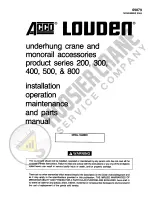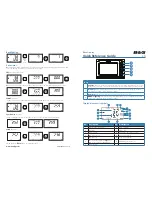
38
4. SPRING RETRACTION FORCE
Attach a small mass (approx. 0.5 kg) to the karabiner and allow the
rope to retract freely. If the main spring is too weak to retract this
weight it must be replaced.
5. REMOVE SHACKLE
(IF PRESENT)
Check for signs of:
- Distortion
- Corrosion or rust
Once removed, the nyloc nut must be replaced
6. REMOVE CRANK ARM
(G.SAVER II ONLY)
Remove handle retaining screw and lift crank arm free of the pinion
shaft.
Inspect the arm for signs of damage or wear. The grip must slide and
lock in and out of position.
7. INSPECT PINION SHAFT
(G.SAVER II ONLY)
The shaft must rotate freely with no excessive bending.
Disengage the trigger assembly in the rear case and ensure the
pinion shaft engages and disengages freely with the pin.
8. REMOVE THE ANTI ROTATION PIN
(G.SAVER II ONLY)
Grip the pin with a pair of adjustable mole grips and unscrew to
remove. Any glue residue left on the thread of the pin must be
cleaned off with a wire brush.
Please note there are two pin lengths depending on the model type.
The older style units, with the bulky aluminium crank arm, have a
longer pin.
Summary of Contents for G.Saver II 400 Series
Page 1: ...SERVICE MANUAL Fall Arresters Includes G Stop G Saver II Issue 006 Date 06 07 21...
Page 19: ...19 G Tripod G Saver II 14m Test Fixture Chain Hoist Load Cell ENGAGED DISENGAGED...
Page 35: ...35 G Tripod G Saver II 20m Test Fixture Chain Hoist Load Cell ENGAGED DISENGAGED...
Page 51: ...G Tripod G Saver II 34m Test Fixture Chain Hoist 51 Load Cell ENGAGED DISENGAGED...
Page 54: ...54 UNIT LABELLING G STOP 7 14 METRE...
Page 55: ...55 G STOP 20 METRE...
Page 56: ...56 G STOP 34 METRE...
Page 57: ...57 G SAVER II 7 14 METRE...
Page 58: ...58 G SAVER II 20 METRE...
Page 59: ...59 G SAVER II 34 METRE...
















































